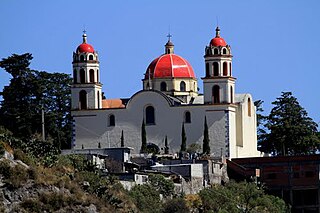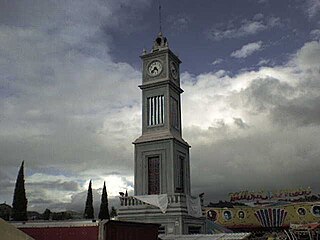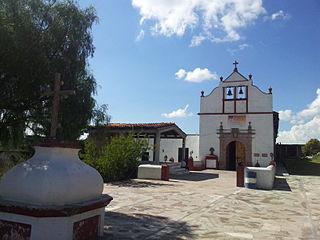
Querétaro, officially the Free and Sovereign State of Querétaro, is one of the 32 federal entities of Mexico. It is divided into 18 municipalities. Its capital city is Santiago de Querétaro. It is located in north-central Mexico, in a region known as Bajío. It is bordered by the states of San Luis Potosí to the north, Guanajuato to the west, Hidalgo to the east, México to the southeast and Michoacán to the southwest.

Juan Aldama was a Mexican revolutionary rebel soldier during the Mexican War of Independence in 1810.

Aljojuca Municipality is a municipality located in central eastern Puebla, Mexico.

Metepec is a municipality in the State of Mexico in Mexico and is located directly to the east of the state capital, Toluca, at an altitude of 2,635 metres (8,645 ft) above sea level. The center of Mexico City lies some 50 km further to the east. The city of Metepec also form part of the Greater Toluca. The name Metepec comes from Náhuatl meaning hill of the agave plants. However, it is also known in the Matlatzinca language as "Nepinta-Tuhi" meaning 'people of corn land' and in the Otomi language as "Ntaguada".

San Juan de los Lagos is a city and municipality located in the northeast corner of the state of Jalisco, Mexico, in a region known as Los Altos. It is best known as the home of a small image of the Virgin Mary called Our Lady of San Juan de los Lagos. Miracles have been ascribed to her since 1632 and have made the Basilica of San Juan de los Lagos a major tourist attraction. The economy of the city is still heavily dependent on the flow of pilgrims to the shrine, which has amounted to between seven and nine million visitors per year.

San Juan Bautista Tuxtepec, or simply referred to as Tuxtepec, is the head of the municipality by the same name and is the second most populous city of the Mexican state of Oaxaca. It is part of the Tuxtepec District of the Papaloapan Region. As of the 2020 census, the city is home to a population of 103,609 and 159,452 in the municipality, though census data are often under reported for various reasons.

Tlaxiaco is a city, and its surrounding municipality of the same name, in the Mexican state of Oaxaca. It is located in the Tlaxiaco District in the south of the Mixteca Region, with a population of about 17,450.
Tlatlaya is one of 125 municipalities of the State of Mexico in Mexico. The municipal seat is the town of Tlatlaya which is the eleventh largest town in the municipality. The word “Tlatlaya” means when the hearth is black and red.

Aculco is a municipality located in the Atlacomulco Region of the State of Mexico in Mexico. The name comes from Nahuatl. The municipal seat is the town of Aculco de Espinoza, although both the town and municipality are commonly referred to as simply "San Jerónimo Aculco".
San Jose Villa de Allende is a town and municipal seat of the municipality of Villa de Allende. It is the fifth largest town in the municipality. It is located 70 kilometers to the west of the city of Toluca. Villa de Allende was named in honor of Ignacio Allende, a hero of the Mexican War of Independence.

El Bosque, Chiapas is a town and municipality in the Mexican state of Chiapas in southern Mexico. It covers an area of 241 km2 (93 sq mi).

San Juan Cancuc is a town and municipality in the Mexican state of Chiapas in southern Mexico.

San Juan de Sabinas is one of the 38 municipalities of Coahuila, in north-eastern Mexico. The municipal seat lies at Nueva Rosita. The municipality covers an area of 735.4 km².
San Juan de Guadalupe is a municipality in the Mexican state of Durango. The municipal seat lies at San Juan de Guadalupe. The municipality covers an area of 2343.1 km².
San Juan del Río is a municipality in the Mexican state of Durango. The municipal seat is at San Juan del Rio. The municipality covers an area of 1279 km².
San Agustín Tlaxiaca is a town and one of the 84 municipalities of Hidalgo, in central-eastern Mexico. The municipality covers an area of 354.6 km2.

Tenango del Aire is a municipality located in the southeast portion of the State of Mexico and is about 42 km southeast of Mexico City. The municipal seat is the town of Tenango del Aire. The municipality is bordered by Temamatla, Tlalmanalco, Juchitepec, and Ayapango. Despite the fact that this municipality is distinctly rural, it falls within the Mexico City Metropolitan Area. The name “Tenango del Aire” came about in two parts. Originally and until 1890, the town was known as Tenango de Topopula. “Tenango” means “walled in” or “fenced by stones.” The second part is due to visits by President Porfirio Diaz, who commented on the winds that are prevalent here. “del Aire” means “of the air.”
Juan Rodríguez Clara is a city and its surrounding municipality in the Mexican state of Veracruz. It is located in the south of the state, about 335 km from the state capital Xalapa. The municipality covers a surface are of 934.20 km2 and the municipal seat is located at 18°00′N95°24′W. Formerly known as El Burro and Nopalapan de Zaragoza, the current name commemorates a local martyr to the cause of agrarianism and was adopted in 1925. The municipality was established on 22 December 1960 from land belonging to San Juan Evangelista.

San Salvador Huixcolotla is a town and municipality in the Mexican state of Puebla in southeastern Mexico that may be best known as the birthplace of papel picado. San Salvador is of Spanish origin and translates to "Holy Savior" and Huixcolotla is Nahuatl for "place of the curved spines".

Yaxkukul Municipality is a municipality in the Mexican state of Yucatán, containing 43.43 kilometres (26.99 mi) of land and located roughly 25 kilometres (16 mi) northeast of the city of Mérida. Survey maps of Yaxkukul cite its full name as "Santa Cruz de Mayo Yaxkukul".














